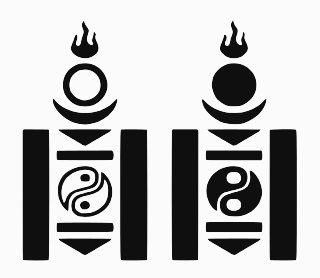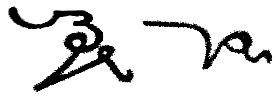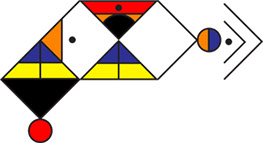An abjad is a writing system in which only consonants are represented, leaving vowel sounds to be inferred by the reader. This contrasts with other alphabets, which provide graphemes for both consonants and vowels. The term was introduced in 1990 by Peter T. Daniels. Other terms for the same concept include: partial phonemic script, segmentally linear defective phonographic script, consonantary, consonant writing, and consonantal alphabet.

An abugida, sometimes known as alphasyllabary, neosyllabary or pseudo-alphabet, is a segmental writing system in which consonant-vowel sequences are written as units; each unit is based on a consonant letter, and vowel notation is secondary. This contrasts with a full alphabet, in which vowels have status equal to consonants, and with an abjad, in which vowel marking is absent, partial, or optional. The terms also contrast them with a syllabary, in which the symbols cannot be split into separate consonants and vowels.

The Soyombo script is an abugida developed by the monk and scholar Zanabazar in 1686 to write Mongolian. It can also be used to write Tibetan and Sanskrit.
Pitman shorthand is a system of shorthand for the English language developed by Englishman Sir Isaac Pitman (1813–1897), who first presented it in 1837. Like most systems of shorthand, it is a phonetic system; the symbols do not represent letters, but rather sounds, and words are, for the most part, written as they are spoken.

Canadian syllabic writing, or simply syllabics, is a family of writing systems used in a number of Indigenous Canadian languages of the Algonquian, Inuit, and (formerly) Athabaskan language families. These languages had no formal writing system previously. They are valued for their distinctiveness from the Latin script and for the ease with which literacy can be achieved; indeed, by the late 19th century the Cree had achieved what may have been one of the highest rates of literacy in the world.

Cree syllabics are the versions of Canadian Aboriginal syllabics used to write Cree dialects, including the original syllabics system created for Cree and Ojibwe. There are two main varieties of syllabics for Cree: Western Cree syllabics and Eastern Cree syllabics. Syllabics were later adapted to several other languages. It is estimated that over 70,000 Algonquian-speaking people use the script, from Saskatchewan in the west to Hudson Bay in the east, the US border to Mackenzie and Kewatin in the north.

Ojibwe is an indigenous language of North America from the Algonquian language family. Ojibwe is one of the largest Native American languages north of Mexico in terms of number of speakers and is characterized by a series of dialects, some of which differ significantly. The dialects of Ojibwe are spoken in Canada from southwestern Quebec, through Ontario, Manitoba and parts of Saskatchewan, with outlying communities in Alberta and British Columbia, and in the United States from Michigan through Wisconsin and Minnesota, with a number of communities in North Dakota and Montana, as well as migrant groups in Kansas and Oklahoma.

Mandombe or Mandombé is a script proposed in 1978 in Mbanza-Ngungu in the Bas-Congo province of the Democratic Republic of the Congo by Wabeladio Payi, who related that it was revealed to him in a dream by Simon Kimbangu, the prophet of the Kimbanguist Church. Mandombe is based on the sacred shapes and , and intended for writing African languages such as Kikongo, as well as the four national languages of the Congo, Kikongo ya leta, Lingala, Tshiluba and Swahili, though it does not have enough vowels to write Lingala fully. It is taught in Kimbanguist church schools in Angola, the Republic of the Congo, and the Democratic Republic of the Congo. It is also promoted by the Kimbanguist Centre de l’Écriture Négro-Africaine (CENA). The Mandombe Academy at CENA is currently working on transcribing other African languages in the script. It has been classified as the third most viable indigenous script of recent indigenous west African scripts, behind only the Vai syllabary and the N'Ko alphabet.
Merrill Shorthand is a shorthand system invented by Albert H. Merrill, published in 1942.

The Duployan shorthand, or Duployan stenography, was created by Father Émile Duployé in 1860 for writing French. Since then, it has been expanded and adapted for writing English, German, Spanish, Romanian, Latin, Danish, and Chinook Jargon. The Duployan stenography is classified as a geometric, alphabetic stenography and is written left-to-right in connected stenographic style. The Duployan shorthands, including Chinook writing, Pernin's Universal Phonography, Perrault's English Shorthand, the Sloan-Duployan Modern Shorthand, and Romanian stenography, were included as a single script in version 7.0 of the Unicode Standard / ISO 10646

The Korean alphabet, known as Hangul in South Korea and Chosŏn'gŭl in North Korea, is the modern official writing system for the Korean language. The letters for the five basic consonants reflect the shape of the speech organs used to pronounce them, and they are systematically modified to indicate phonetic features; similarly, the vowel letters are systematically modified for related sounds, making Hangul a featural writing system. It has been described as a "syllabic alphabet", as it combines the features of alphabetic and syllabic writing systems, although it is not necessarily an abugida.
Ga is the third consonant of Indic abugidas. In modern Indic scripts, ga is derived from the early "Ashoka" Brahmi letter , which is probably derived from the Aramaic letter after having gone through the Gupta letter .
Inuktitut Braille is a proposed braille alphabet of the Inuktitut language based on Inuktitut syllabics. Unlike syllabics, it is a true alphabet, with separate letters for consonants and vowels, though vowels are written before the consonants they follow in speech. It was published in 2012 by Tamara Kearney, Manager of Braille Research and Development at the Commonwealth Braille and Talking Book Cooperative. The book ᐃᓕᐊᕐᔪᒃ ᓇᓄᕐᓗ The Orphan and the Polar Bear was the first work transliterated into Inuktitut Braille.
Ṭa is a consonant of Indic abugidas. It is derived from the early "Ashoka" Brahmi letter after having gone through the Gupta letter . As with the other cerebral consonants, ṭa is absent from most scripts not used for a language of India.

Ditema tsa Dinoko, also known by its IsiZulu name, Isibheqe Sohlamvu, and various other related names in different languages, is a constructed writing system for the siNtu or Southern Bantu languages, developed in the 2010s from antecedent ideographic traditions of the Southern African region. Its visual appearance is inspired by these, including the traditional litema arts style. It was developed between 2014 and 2016 by a group of South African linguists and software programmers with the goal of creating a denser writing system to avoid the slowness in reading caused by the word length and visual homogeneity of Southern Bantu languages written in the Roman alphabet.
Pa is a consonant of Indic abugidas. In modern Indic scripts, Pa is derived from the early "Ashoka" Brahmi letter after having gone through the Gupta letter .
Ma is a consonant of Indic abugidas. In modern Indic scripts, Ma is derived from the early "Ashoka" Brahmi letter after having gone through the Gupta letter .
Ya is a consonant of Indic abugidas. In modern Indic scripts, Ya is derived from the early "Ashoka" Brahmi letter after having gone through the Gupta letter .
Sa is a consonant of Indic abugidas. In modern Indic scripts, Sa is derived from the early "Ashoka" Brahmi letter after having gone through the Gupta letter .
E is a vowel of Indic abugidas. In modern Indic scripts, E is derived from the early "Ashoka" Brahmi letter after having gone through the Gupta letter . As an Indic vowel, E comes in two normally distinct forms: 1) as an independent letter, and 2) as a vowel sign for modifying a base consonant. Bare consonants without a modifying vowel sign have the inherent "A" vowel.








